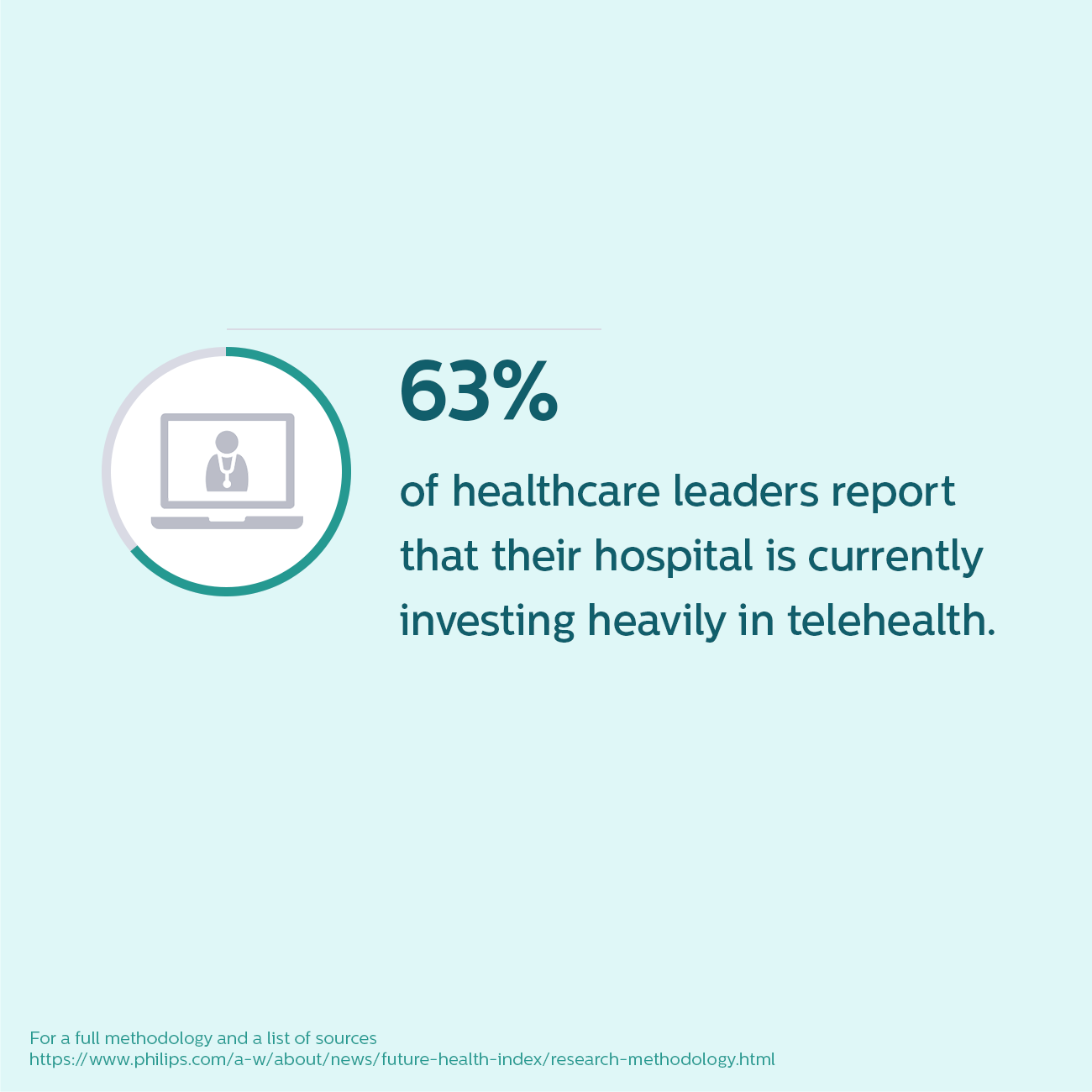Jul 19, 2021
Accelerating Australia's Digital Health Agenda
The role of digital health technologies in achieving health system resilience
The global pandemic has challenged almost every aspect of our lives, with fundamental shifts in everyday life now evident. Many of the solutions to the problems presented by COVID-19 centre on digitising traditional touchpoints. In fact, in under 24 months, digital touchpoints have become expected by consumers and patients, with digital transformation initiatives leading to higher interest and engagement. In response, decision makers across a range of industries have turned to technology to help solve problems stemming from changing demand and expectations. Healthcare has been no different. Traditional healthcare workflows operating in Australia have been challenged to innovate in the wake of a global pandemic. Industry-wide, we have seen the tangible impact of technology adoption in ensuring continuity of care.
The Philips 2021 Future Health Index found Australia’s healthcare leaders have embraced an adoptive mindset towards digital solutions, with the Australian health system increasingly focused on long-term technology investment. In 2021, almost two in three Australian healthcare leaders reported their top investment priority was establishing robust telehealth solutions for patients and practitioners. By 2024, 77 per cent of healthcare leaders state their top investment priority will be more advanced predictive technologies like AI and machine learning, rising from just 33 per cent in 2021.

We’re already seeing evidence of best practice digital adoption and engagement across the Australian healthcare landscape. While these case studies of digitisation are impressive and in many cases world leading, they remain isolated examples of best practice that must scale to have a more significant impact. Also, despite a wide range of technologies currently available to Australian healthcare leaders, we have not seen the same rate of adoption and engagement as witnessed in other developed nations, such as the United States. In 2019, just 11 per cent of US consumers used telehealth services, with that number increasing to nearly one in two consumers using telehealth technologies to replace cancelled healthcare visits in 2021. While Australia has recorded more than 56 million telehealth consultations, engagement remains more concentrated demographically. For Australian healthcare to modernise, industry stakeholders must address the questions posed by patients, practitioners, and government organisations. Firstly, what does a national digital healthcare system in Australia look like and what benefits can this system provide both patients and practitioners? While developing a roadmap towards wider digital adoption, learning from existing pockets of best practice and championing their success will be a vital part of showcasing how digital solutions can deliver better patient outcomes. Defining digital health solutions and their benefits A clear and cohesive digital health framework must be established among Australia’s healthcare stakeholders. Industry stakeholders engaged in this transformation agenda have a responsibility to present the ideal digital health workflow after having considered what is achievable, in a format that is both well understood and clearly demonstrates the benefits of widespread adoption to both practitioners and patients. The process of defining digital health solutions plays a vital role in outlining the benefits that these new workflows can deliver. It is important that stakeholders first consider the existing measurement tools used by federal and state governments when presenting the opportunities brought forward by digitisation, to ensure a direct comparison is possible. These updated metrics must measure both the healthcare and economic benefits being delivered through digital adoption and integration, to ensure a wide selection of stakeholders are proactively engaged in pushing digital adoption forward. When encouraging patients to engage in these new methods of care delivery, a core component likely to encourage adoption centres on personal choice. At the heart of these changes is an opportunity to better respond to the care needs of Australians. The adoption of digital health solutions allows Australia’s healthcare industry the opportunity to implement a hybrid model of care delivery, not only presenting patients with choice but also allowing for the parallel measurement of traditional and digital care delivery success. Measuring and promoting success Industry stakeholders must work together to both develop a robust method of measuring the impact of best practice solutions and showcase the examples of best practice currently operating in Australia. This programme of work must exist alongside a plan to engage all stakeholders proactively to further promote and scale digital understanding and education. A vital consideration is defining the roles and responsibilities of promoting the benefits of digital health solutions to various decision makers across the Australian health landscape. There is a range of different stakeholders, all requiring unique value propositions to encourage adoptive stances. For example, decision makers within government must be presented with solutions to both short- and long-term health system challenges, while healthcare practitioners and organisational leaders must see solutions to more acute system challenges raised by digital adoption, including budget constraints and staff shortages. In summary, patients must understand the key advantages of digital healthcare adoption, both in the short term and for the long term – specifically, growing the rate of self-determination and implementing patient choice with more touchpoints and an opportunity for care to centre on prevention, not just engaging when the need for care becomes critical. These pockets of existing best practice where digital solutions are being successfully implemented in Australia can become case studies to help scale adoption across both the public and private sectors. This is the case with AusHSI’s economic impact report on the West Moreton Health District remote patient monitoring program, MeCare, which makes a strong case for government decision makers to further invest in digital solutions. Moreover, actively engaging with independent and widely trusted organisations such as the CSIRO, now responsible for integrating and expanding the use of AI into national systems is encouraged. Stakeholders invested in the wider adoption of digital health solutions must work together in partnership to increase understanding of the benefits of digital health technologies. Research from the Philips 2021 Future Health Index found 35 per cent of healthcare leaders are prioritising partnerships to further their digital innovation agenda, with 45 per cent stating they will prioritise partnerships with health informatics companies to facilitate greater digitalisation. Defining the role of government While the private health system is often seen as being at the cutting edge of innovation, rarely do innovative processes in healthcare take hold without public sector support. Government organisations, both state and federal, will play a critical role in expanding the adoption of digital health solutions. Government can lead the scaled implementation of digital health solutions in Australia as they are capable of developing the criteria for success, funding innovation, monitoring the rate of adoption, and enforcing best practices for the use of digital solutions sitting with the public sector, while providing funding for the implementation of such solutions. Of additional critical importance will be the government’s role in incentivising behaviours of adoption, both for digital health solutions and value-based care. Also, government organisations already possess cross-sector expertise that can help address the issues currently experienced by the Australian healthcare system, including limited experience using these updated models of care delivery. In many circumstances, the major issue for healthcare leaders is staff inexperience and expertise using digital health technologies, with 43 per cent of respondents to the Philips 2021 Future Health Index stating it is a key barrier to future planning. Both state and federal government organisations can help solve this challenge, by implementing more robust digital training and education initiatives. This can also help address investment shortfalls being seen at an operational level, where only 30 per cent of respondents cite a commitment to investing in workplace training to successfully implement digital technologies. Incentivising innovation Likely the most effective method of incentivising change focuses on evolving existing reimbursement models for the delivery of care. Despite evidence of the benefits of digital adoption and value-based care models, Australian healthcare leaders remain somewhat hesitant. According to the Philips 2021 Future Health Index, while one in five Australian healthcare leaders reported having already adopted value-based care models at their healthcare facility, 20 per cent of respondents stated they had deprioritised their adoption plans due to the challenges presented by existing reimbursement models, instead returning to a fee-for-service model. The Australian Government can play a proactive role in digitising Australia’s healthcare future and accelerating the adoption of value-based care models by financially incentivising organisational innovation. With the government in firm control of how healthcare organisations, both public and private, are reimbursed for the delivery of care, a reform of funding models will need to take place to drive greater adoption. Programs to further incentivise digital health adoption are being implemented by private health funds, with Medibank’s At Home program presenting customers with the option of remote rehabilitation services while actively promoting its benefits to a wide audience of healthcare consumers. Additionally, the government has the resources and experience to ensure digital adoption continues to expand, via established organisations like the Australian Digital Health Agency and state-based health departments, meaning they are capable of overseeing the effective implementation and use of digital health solutions. Moving forward The challenge of COVID-19 has spurred innovation across the Australian health sector, and a sense of intrigue into the capabilities of digital health solutions among healthcare leaders. Digitisation faces challenges to widespread adoption on a scale similar to that of a pandemic, with a wide range of barriers preventing best practice adoption nationally. Partnerships between healthcare leaders, government organisations, educational institutions and health technology experts are the path to overcoming these challenges. With a robust healthcare system already in place and a well-funded federal innovation strategy, Australia is positioned to capitalise on digital opportunities. Australia’s approach to a digital health system could provide a roadmap that can be followed by the rest of the world.
What does it take to maintain a resilient health system? Download the Future Health Index 2021 report and learn about the perspectives of Australian healthcare leaders and their plans for the future.
About Royal Philips
Royal Philips (NYSE: PHG, AEX: PHIA) is a leading health technology company focused on improving people's health and well-being, and enabling better outcomes across the health continuum – from healthy living and prevention, to diagnosis, treatment and home care. Philips leverages advanced technology and deep clinical and consumer insights to deliver integrated solutions. Headquartered in the Netherlands, the company is a leader in diagnostic imaging, image-guided therapy, patient monitoring and health informatics, as well as in consumer health and home care. Philips generated 2020 sales of EUR 19.5 billion and employs approximately 82,000 employees with sales and services in more than 100 countries. News about Philips can be found at www.philips.com/newscenter.
Topics
Contacts

Sarah Al-Hashimi Brand & Corporate Communications Manager Tel. : +61 (0) 402117768
You are about to visit a Philips global content page
ContinueAuthor

Matt Moran
Managing Director of Philips in Australia and New Zealand Matt Moran is the Managing Director for Philips in Australia and New Zealand. With over 25 years at Philips, Matt has held various leadership positions in Australia, Singapore and Europe and across different areas of the company, supporting its transformation from a consumer electronics company to a global leader in health technology.
You are about to visit a Philips global content page
Continue
